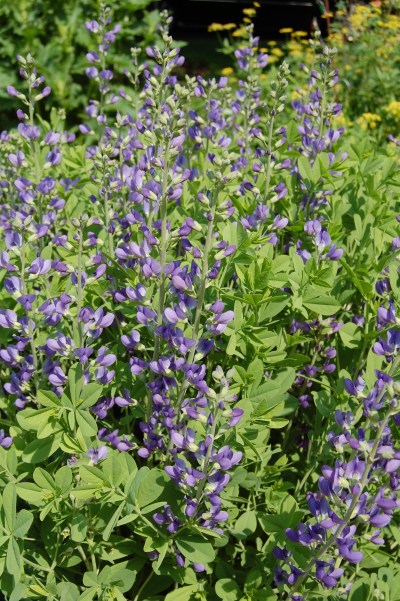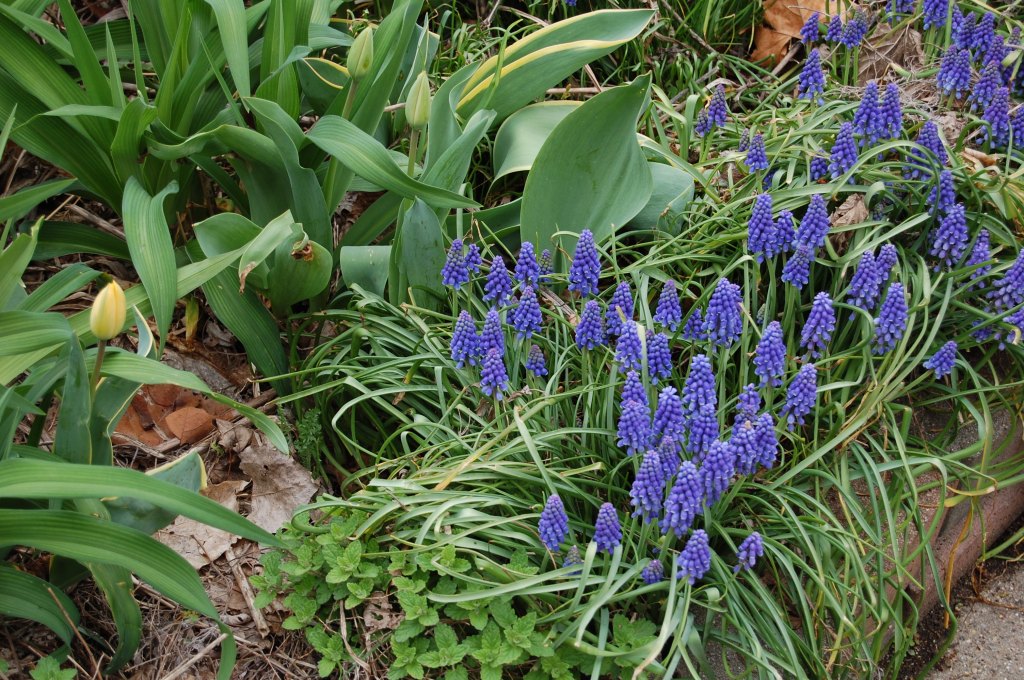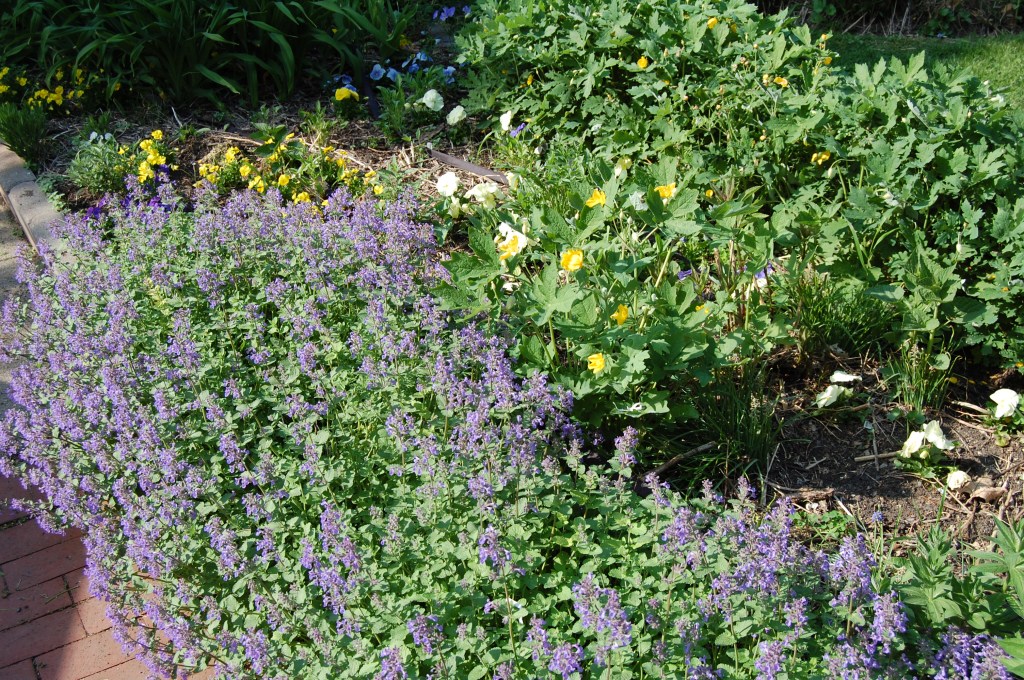Mo’ Better Blue (Flowers)
Recently I wrote about five favorite blue flowers, limiting myself to natives of the American Midwest. The comments that followed revealed that I am far from alone in having a soft spot for blooms of blue. And so I found myself inspired to do another post on the topic, this time not limiting myself to natives.


Wild blue indigo (Baptisia australis). A plant I really should have included in my first post, as it is a native of this region, and certainly a favorite of mine. It has tall stalks of lupine-like flowers in late spring and early summer. Christopher Lloyd thought that the blue-green rounded foliage complemented the flowers very nicely (I’ve started reading his garden books, so expect me to become an insufferable name-dropper). This plant’s only faults are that it is slow to establish and hates to be transplanted. It’s very long-lived, though.

Bluebeard (Caryopteris x clandonensis ‘Longwood Blue’). I just planted this one last spring and already I love it. Normally a low shrub, north of zone 7 it dies back to the ground over the winter. I am a bit worried about mine given how harsh the weather has been. The late season blooms are beloved by butterflies.

False forget-me-not (Brunnera macrophylla). This plant really needs a consultant to come up with a new common name. A false forget-me-not sounds like it really intends to forget. It’s other common name is Siberian bugloss, which is not an improvement. How about Siberian forget-me-not? That’s a bit better. Anyhow, this is a very easy perennial for moist shade. It has sky blue flowers in spring very much like forget-me-nots (Myosotis sylvatica). I like the texture of the large, heart-shaped leaves, and prefer the straight species to the variegated cultivars.

Grape hyacinth (Muscari armeniacum). A wonderful small bulb that will create big drifts if allowed to. The racemes have clusters of tiny blue bells that really do look like bunches of grapes. Blooms in May in Chicago, and is very undemanding.


Catmint (Nepeta x faassenii ‘Kit Kat’). An easy, drought tolerant perennial that likes hot sun. ‘Kit Kat’ is a shorter perennial that for me blooms from mid-spring to early summer. The flowers are small but profuse, and covered with bees. The fine grey-green foliage has a minty smell. I also have the cultivar ‘Walker’s Low’ which is much taller (the name is misleading) and blooms later in the season.
That last picture reminds me that blue looks more blue if there is something red, orange, or yellow nearby to set it off. Blue alone can be a bit dull, it needs some contrast to set it off.
Do you like to contrast blue flowers with brighter colors?





I am looking forward to reading people’s replies so I can learn some tricks. I love blue flowers but they always seem to recede when I plant them next to other flowers. Echoing blue flowers with blue objects seems to work better for me. I tried planting a few mounds of veronica (georgia blue) near a periwinkle arbor and I think that helped the flowers be even more noticeable.
I like the idea of blue flowers with blue objects – in fact I would really like some light blue containers. But I still want some bright flowers with my blue ones.
I am a fan of blue flowers. Last year I planted delphinium (a gorgeous, rich bright blue) in my St. Louis, MO garden but the summer heat proved to be too much. I like the complement of a bright pink next to blue as well as yellow. I have not limited blue in my gardenscape to flowers and have planted blue hued hosta as well as a dwarf blue spruce, which is beautiful in the wintertime when the yard is lacking color.
Have you ever tried the native delphinium, D. exaltatum? I had it for a while and it was really nice while it lasted. May be more up to our regional climate than the usual cultivars.
No. I had not heard of this cultivar. I will look for it at my nearby nursery as I really like the vertical form (the bones of my beds are rounding/mounding forms for the most part) of delphinium. I have read they are a difficult plant to maintain, and given my lifestyle and newbie gardening status I am all about easing into this enjoyment.
You may have to order it online – try Prairie Nursery in Wisconsin.
Wow look at that bee picture! Gorgeous!
My wife Judy took that, it is one of her best I think. Actually, she takes almost all the pictures.
Don’t worry Jason if your Caryopteris x clandonensis ‘Longwood Blue’ is very late to start showing any signs of life. That’s normal, even mine here, where the winter has been incredibly mild are not yet showing any buds.
The challenge is not to slice into the crown before they sprout. Same problem with butterflyweed.
I’d like to hear how the Caryopteris has done as I have tried growing them a few times and they never survive our winters… or did I do something else wrong?! The German name for Brunnera is Caucasus Forget-me-not… also not a pretty prefix. Russian sounds nicer. I like blue and white, or blue with silvery foliage, but a splash of colour is unavoidable in my garden!
Russian forget-me-not does sound better than Siberian. Maybe we should just be really inclusive and call it Eurasian forget-me-not.
love the blue with brighter colors. I just love seeing sunshine even if it is just in pictures.
We actually had some today.
beautiful flowers 🙂
Thank you!
I admire blue flowers too. Your post reminds me I forgot to add Brunnera macrophylla to my garden. Really like the look of that.
It’s a great plant, just needs moisture.
Muscari are my favorite as well, Jason! Love this bright blue color we all need it after long winter, don’t we?
Exactly! And you can never have too many!
Jason, have you ever grown globe thistle? If not, I recommend it. My mother used to grow it in her garden in White Plains, NY and I remember that it was always covered with bees. I have loved this plant forever (probably as much for sentimental reasons as anything else) but I suspect it is too hot in North Carolina to grow it successfully. However, it would probably be great in Chicago.
I have not grown it, not sure why. Maybe I’ll put in a few. Reminds me of Allium.
It’s not often I can say I have every one of these in my garden, too, and love them! I planted a caryopteris two years ago and have grown to love it so much I planted another last year. What I really like about it is that it blooms in late summer when so many other blooms have faded. The hummingbirds enjoy it, too. I’m a pastel kind of gal, so I usually plant pinks or even whites with blue, but that red poppy really has me inspired to think of bolder contrasts.
White and blue is very calming, and I agree that pink and blue can also be nice.
Lovely pics. I also have nepeta and poppy growing in my mountain garden. Got Baptisia last year and look forward to growing it, fab plant. Brunnera is flowering here as well. One of my favourites and true blue.
Be patient with the Baptisia and it will reward you.
I missed the first part of this post Jason so please forgive me if I repeat anything that might have been said previously.
I’m always drawn to blue flowers – although prefer to see them with softer pinks – a combo that always reminds me of summer. Nepeta is a favourite of mine yet sadly the cats love it too!
Yes, the cat’s do love it but for me at least it has been pretty resilient, even with felines rolling around on top of it.
Wild blue indigo, Baptisia australis is probably my favourite blue. I actually like mixing blue flowers with other blue flowers and also with white and soft pink flowers. There is just something so soft and pretty about those combination of colors.
Quite a few people have mentioned that they are partial to those combinations.
I wonder if the Chicago Botanic Garden prunes its Nepeta Walker’s Low when it is just coming out? Mine is beautiful but very floppy whereas in your picture it seems to stand up well.
I don’t know, that’s a good question.
I love blue flowers too. It is great with pastel shades but my favourite combination is a summer one of blue and yellow. It has to be true blue; no mauve or purple. I’ ll show you what I mean in June or July.
Yes, I love the combination of blue and yellow, though also blue and red and blue and orange.
Blue and anything really.
I love Blue indigo as well and am sometimes tempted to plant more and more of it because it is a remarkable plant : easy, pretty, drought tolerant, native, long blooming, pretty after bloom … it has all the qualities of a good garden plant.
It is an excellent plant. Just wish it grew faster.
Love contrast and I have so many Walker’s Low I lost count. I have lots of it because of the smell and the deer don’t like it. 🙂
I have more of the Kit Kat because it’s shorter and easier to use at the front of the border.
The baptisia is awesome, I just wish it didn’t get so big afterwards. Did you ever try transplanting it? I always hear it’s tough to move but mine didn’t skip a beat. It was a bear to dig out because of the size but that was the only problem.
I never have wanted to move it, but have always accepted the conventional wisdom that it is hard to transplant. Makes sense as it has a taproot.
I have had Caryopteris for years. It does not necessarily die back to the ground. I cut off the die-back in Spring and usually am left with a plant almost the same size. You will find it short-lived. I had one for six years and just removed it last year, They get rather woody. They seed well, so I am always having replacements. I have Walker’s Low too and that is another plant that has a short life in the garden. The cats destroy it no matter what the tag says on it not being like the species. I love the blues in the garden. It is such a restful color and goes so well with almost any other color too.
I was just examining one of my Caryopteris that has lost its snow cover. It does look like it has not died down to the ground, even in this horrible winter.
I do like to see blue used with yellow or orange, but you showed a photo here once that had large beds of blue and white flowers and I thought that was beautiful.
Jason I love your choices here too…can’t wait to see blue flowers soon…I think that is why I plant so many early blue spring bulbs
I loved all these Jason, especially the catmint, I’m growing that from seed this year, and my Muscari is now out!xxx